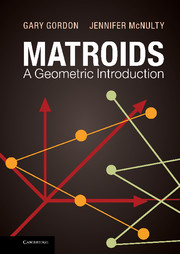7 - Other matroids
Published online by Cambridge University Press: 05 November 2012
Summary
Matroids are an important generalization of graphs and matrices; graphic and representable matroids have been the focus of much of the text. But other important combinatorial structures also have interpretations as matroids. In this chapter, we concentrate on two well-studied applications: transversalmatroids (which arise from bipartite graphs) and hyperplane arrangements in ℝn, which are closely related to representable matroids.
Transversal matroids
Finding matchings in bipartite graphs is an extremely important and well-studied topic in combinatorics. For instance, the job assignment problem introduced in Example 1.20 in Chapter 1 asks you to determine which applicants to hire for a collection of jobs. This motivates the notion of a transversal matroid, a matroid associated with matchings in a bipartite graph. These matroids were defined in Example 1.20, and Theorem 7.2 asserts the collections of vertices that can be matched to satisfy the independent set axioms. In Chapter 1, we postponed the proof until “later.” Now, it's later.
In an effort to make this chapter self-contained (and to spare you the trouble of leafing back to Chapter 1), we remind you of all the relevant definitions. Let G be a bipartite graph with vertex bipartition V = X ∪ Y. Recall a subset of edges N is called a matching if no two edges ofN share any vertex. We writeN = (I, J) for I ⊆ X and J ⊆ Y for the vertices that the matching N uses in X and Y, respectively.
Information
- Type
- Chapter
- Information
- Matroids: A Geometric Introduction , pp. 261 - 295Publisher: Cambridge University PressPrint publication year: 2012
